|
The Collection continued:
III. Later Angel Chimes
As with so
many things, candle chimes divide neatly into categories of
“Pre-War” and “Post-War” manufacture. Before World War II, most
chimes were made in Germany of lithographed tin, exhibiting — like
other tin toys of the period — lots of pictorial and/or embossed
detail, and many moving parts. World War II killed both the export
and German domestic markets for candle chimes and other tin toys for
the duration, and for a significant period thereafter. Swedish and
other northern European makers eventually arose to meet a continuing
post-war demand for candle chimes, but took the opportunity to
impose a different aesthetic. Post-War chimes involved somewhat
fewer pieces than their Pre-War cousins, were much simpler in
outline and detail, and were generally stamped from unadorned flat
brass, rather than embossed lithographed tin.
|
|
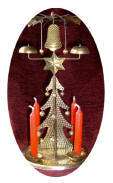 Heli
“Christmas Chimes” (29 x 13.5 cm., base = 14 cm. dia.) Heli
“Christmas Chimes” (29 x 13.5 cm., base = 14 cm. dia.)
This American
import is by the same east-German maker as the earlier example.
Although entirely of brass, the low-relief modeling of the major
design elements is a holdover from more elaborate pre-war candle
chimes. Use of a bell as a central decorative feature is unique to
this chime; other versions incorporated Lauscha glass decorations as
part of the decorative scheme. The Christmas-tree base proved
popular and long lasting.
|
|
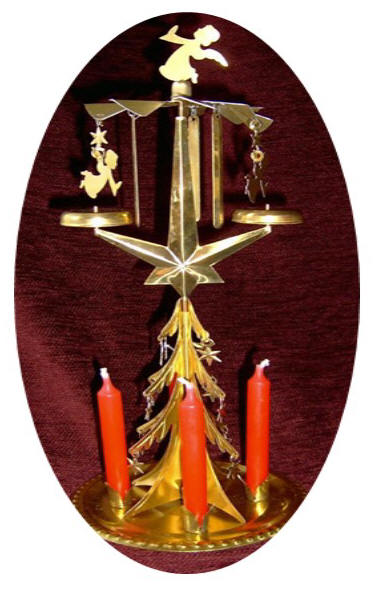 Heli
“Glockenspiel/Christmas Chimes” (29 x 13.5 cm., base = 14 cm. dia.) Heli
“Glockenspiel/Christmas Chimes” (29 x 13.5 cm., base = 14 cm. dia.)
A relatively
modern German chime with Christmas tree base and an angel topper
reminiscent of Swedish designs. There is no maker’s mark, but the
distinctive Christmas tree base marks this chime as a descendant of
the “Heli” products discussed earlier. I have seen this and similar
designs described on the German eBay site as “DDR-Engelsgeläut,” or
East German angel chimes.
|
|
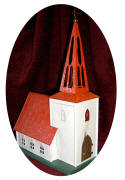 “Country
Church Chime” (37 cm. high x 21 cm. long x 13.5 cm wide) “Country
Church Chime” (37 cm. high x 21 cm. long x 13.5 cm wide)
This "Country
Church" chime dates from sometime in the 50s or 60s, but its painted
tin construction is a throwback to earlier pre-WWII chimes. The
design is ambitious, but not very well engineered, and the
configuration of the moving parts is awkward.
|
The Collection continued:
IV. Swedish-Pattern Angel Chimes
In the postwar years, aggressive marketing
of simple, well-designed and carefully-engineered “Swedish pattern”
candle chimes through Sears and other American outlets led to a
significant rise in popularity of these toys, despite the
simultaneous explosive increase in the sales of electric Christmas
lighting. Indeed, variants of the popular Swedish pattern chime are
still available today. Despite the claim to derive from “a beautiful
old Swedish original,” almost every important feature of these
modern Swedish pattern angel chimes derives from German models —
particularly those of Adrian & Stock — of the early 20th century.
The family resemblance is striking, particularly in the “floating
angels” with their bell-clappers, and distinctive pompadour hairdos.
A brief history in English of one Swedish manufacturer of angel
chimes can be found at
http://smpab.se/htm/history.htm. |
|
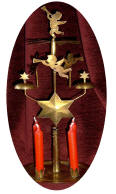 “Änglaspelet”
(Angel Carillon) (34.5. x 13.5 cm., base = 13 cm. dia.) “Änglaspelet”
(Angel Carillon) (34.5. x 13.5 cm., base = 13 cm. dia.)
This very
early post-WWII Swedish “Änglaspelet” forms an interesting link
between the Stock designs of the early 20th century and today’s
Swedish pattern angel chimes. The box includes directions for
assembly in both English and Swedish.
Although the
plain base design and die-cut angels, as well as the exclusive use
of brass, mark it as a Swedish-derived product, most of the key
design elements — the spiral “spring” support, the central star, the
shape of the bell supports, the tiny stars atop the chimes — are
obviously adapted from pre-war Adrian & Stock designs: compare this
post-war chime, element by element, with a “No. 3” Adrian & Stock
chime from the 1930s.
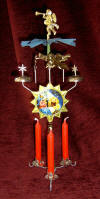 |
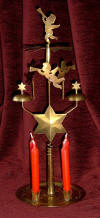 |
|
Adrian & Stock |
Swedish
Änglaspelet |
|
|
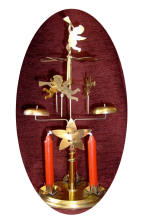 Holt
Howard “Angelabra” (33 x 14.5 cm., base = 11.5 cm. dia.) Holt
Howard “Angelabra” (33 x 14.5 cm., base = 11.5 cm. dia.)
Another early
transitional design, identical to the modern Swedish pattern in most
respects. Holt Howard Associates were based in New York City, but it
is not clear whether this chime was produced in the U.S., or
imported from overseas. The instructions include a charming (but
highly unlikely) story on the origins of the “Angel Abra” chime.
|
|
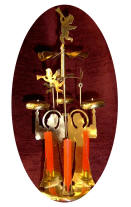 Sudhouse
“Weihnachts Glockenspiel” (Christmas Carillon) Sudhouse
“Weihnachts Glockenspiel” (Christmas Carillon)
(33 x 13.5 cm., base = 11 cm. dia.)
Elements of
the very popular post-war Swedish chimes were sometimes copied (or
perhaps “repatriated” is a better word) by German manufacturers.
Dating to the 1950s, this “Weihnachts Glockenspiel” by the West
German firm of Sudhouse has a unique patented base with a trio of
chime-bearing angels, but its superstructure of “floating” cherubs
is identical to contemporary Swedish models. The directions for
assembly are given in both German and English.
|
|
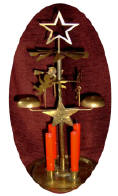 “Klockspel”
(Carillon) (32 x 14 cm., base = 14 cm. dia.) “Klockspel”
(Carillon) (32 x 14 cm., base = 14 cm. dia.)
An attractive and well-made variant of the Swedish
pattern chimes, with a star instead of an angel as the top ornament.
|
|
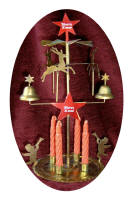 “Jingle
Abra” (32 x 17 cm., base = 13 cm. dia.) “Jingle
Abra” (32 x 17 cm., base = 13 cm. dia.)
This imported
“Jingle Abra” is by far the most elaborate post-war Swedish pattern
chime this collector has seen. Lithographed red stars, a small herd
of reindeer, and a flanking pair of trumpeting angels harkens back
to the complicated Adrian & Stock designs of the 1930s, a refreshing
departure from the relatively austere designs of the post-war era.
|
HOME
TABLE OF CONTENTS
BACK
NEXT
|
































